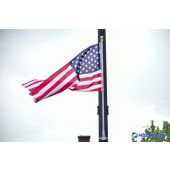Buy Ecuador Flags

Flag of Ecuador
The Ecuador flag, like the flag of many other nations in South America, dates back to the period immediately following the wave of revolutions that swept the nation in the early 19th century. That shared heritage means that Ecuador flags bear a strong resemblance to the flags of the nations that surround it, but it also has distinctive features that provide clear links to the unique national character of Ecuador.
- Capital of Ecuador: Quito
- Area of Ecuador: 276,840 sq. km
- Languages used in Ecuador: Spanish (official), Amerindian languages including Quechua
- Religions in Ecuador: Roman Catholic
Colors and Symbolism of the Ecuador Flag
The Ecuador flag is a horizontal tricolor of yellow, blue, and red that features the nation's coat of arms in the center. The coat of arms represents the nation of Ecuador as a whole, and it depicts some of the nation's most distinctive natural wonders. Each of the stripes also represents an important aspect of the land and people of Ecuador. The yellow stripe stands for the fertile land and the crops that grow in it, the blue stripe represents the ocean and the sky, and the red stripe represents the blood that the Ecuadorian people shed to win their independence from Spain during their revolution. Those colors were chosen in part due to a meeting between an Ecuadorian general and the great polymath Goethe, who taught the general about color theory.
History of Ecuador Flags
Ecuador's first national flag had five alternating stripes of blue and white with three white stars in the center stripe, but that flag was only used for two years. It was briefly replaced by a new national flag that had a white field with a blue square featuring a white star in the canton, but that flag fell out of use when Ecuador became part of Gran Colombia. Gran Colombia's flag established the red, yellow, and blue that would be part of most future Ecuador flags. Ecuador chose to use Gran Colombia's flag without the national crest when it declared independence, and it used that flag for ten years before a revolutionary movement briefly took power and replaced the flag with a blue and white bicolor with white stars. Ecuador adopted the earliest form of the modern flag in 1860, and it added the nation's coat of arms to create the modern form in 1900.

